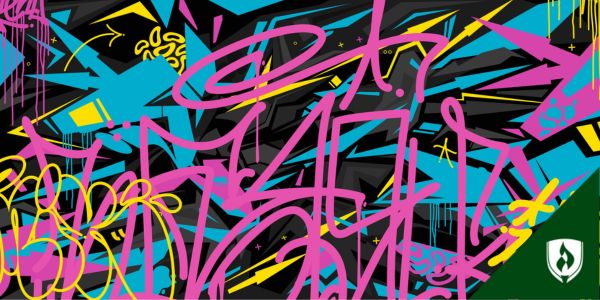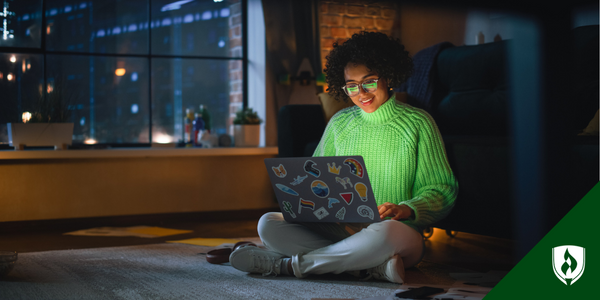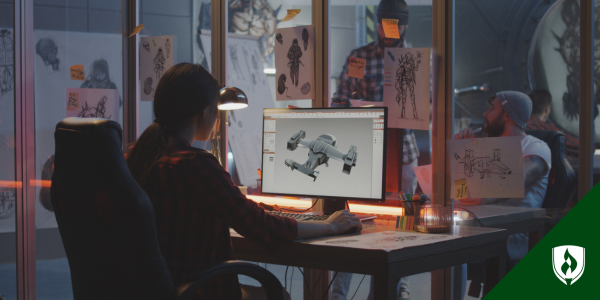
Growing up, you were always an ace in art classes and jumped at the chance to take on fun creative projects. Now that you’re making career plans, you can’t help but wonder if that creative enthusiasm could be applied to a career as a graphic designer. But making the transition from doing creative things for the fun of it to working as a graphic designer professionally is a big jump—and you want to know more about the job before making any commitments.
To help you get a better handle on what to expect in a graphic design career, we’ve researched and compiled answers to key questions—and asked professionals to provide insight into the parts of this role that you won’t find in a graphic designer job description.
Key questions about graphic design careers
Before we get into the finer points of working as a graphic designer, let’s first address some of the big picture questions you may have about the role.
What do graphic designers do?
Graphic designers create designs and layouts for everything from hot sauce packets to book jackets. Their designs are intended to evoke a specific feeling from an audience—whether that’s the calming, secure professionalism of a bank or the youthful vibrancy of a clothing store for teens. They are experts at bringing a brand or message to life and often work in advertising and marketing.
Graphic designers will frequently work with strategists, clients, art directors and copywriters to brainstorm ideas, create mockups, incorporate feedback, and eventually produce a design that tells a story and motivates viewers to take action.
In this role they use design technology such as Adobe Photoshop®, Illustrator®, and InDesign® to coordinate text, spacing, colors, images, and everything else that goes into making a logo or layout look just right.
What skills does a graphic designer need?
Successful graphic designers need an interesting blend of skills. They obviously have to be artistic or creatively-inclined. But they are also very analytical, evaluating what audience they’re designing for and what message a design will send. On top of that, they must be savvy enough to stay up to date on design software and personable enough to communicate with coworkers and clients—no small feat, particularly with those whose feedback may be frustrating. According to the Bureau of Labor Statistics (BLS), these are the most important qualities of a graphic designer:1
- Analytical skills
- Artistic ability
- Communication skills
- Computer skills
- Creativity
- Time-management skills
Looking for more information about what it takes to succeed? Check out our article, “6 Overlooked Qualities of a Standout Graphic Designer.”
Where do graphic designers work?
Graphic designers can either work in-house, at an agency or as a freelancer. In-house, you would typically be working for one brand serving their graphic design needs. At an agency, you would work for a company that’s hired to design for a variety of brands. Freelance means you find your own contracts with clients and work where you want. Despite some of the unique challenges that come with being a freelancer, it is a fairly common path—the BLS reports 22 percent of graphic designers were self-employed in 2018.1
Freelancing is a big wildcard in earning potential. Those who depend fully on self-employment don’t always have consistent income streams and need to budget for down times. Another factor to consider is the potential to add income from freelance side projects to earnings from a more traditional 9–5 graphic design role.
These work environments all have their pros and cons. Our article, “Where Do Graphic Designers Work? In-house vs. Agency vs. Freelance,” goes into further detail.
How do I become a graphic designer?
Most graphic designers need a Bachelor’s degree in Graphic Design. While there are certainly tutorials and DIY videos that can help you pick up some of the tricks of the trade, an education can help you stand out from the competition and develop your portfolio under expert guidance.
Having a diverse portfolio is essential to getting hired and finding clients. Pursuing further internships will also help you develop your experience and increase your standing in the job market.
How is the job market for graphic designers?
Overall, the BLS projects a 3 percent increase in employment for graphic designers by 2028 which is below the average for all occupations.1 However that’s only part of the story—you’ll find that there’s a strong variance in job growth projections from industry to industry. For example, the BLS states that employment of graphic designers for newspapers, periodicals, books and directory publishers is projected to decrease by 22 percent from 2018-2028.1 While that certainly isn’t a positive, there’s stronger growth elsewhere, with the BLS projecting graphic design employment in computer systems design and related fields growing at a rate of 24 percent from 2018-2028.1
That being said, the graphic design market is still very competitive, making a solid education and portfolio all the more important.
Going beyond the graphic designer’s job description
Job descriptions are helpful, but we also know that every job has its surprises. How can you know what the job is really like if you can’t get an inside look? We connected with a variety of designers to give you a better idea of what’s behind the traditional job description, and here’s what we found.
You’re going to have to compromise
“The hardest thing to adjust to is having to compromise what you think are brilliant ideas to your design team and having to design what a client wants,” says artist and designer Pablo Solomon. When clients aren’t informed on design rules and theory, they often don’t know that ALL CAPS or Comic Sans may send the wrong message.
There’s a lot of back and forth that goes into creating a new logo or refreshing a brand, so it will be important that you’re willing to give up a certain amount of creative control in order to appeal to who you’re working for.
The same goes for working with a design team. You might shudder at your colleague’s idea to use lime green for a logo. But then, your colleagues might think your concept of delicate lines and gentle curves is fussy. It’s all give and take, and learning how to work together in a creative capacity will only serve you well in the end.
Managing expectations is key
“A graphic designer needs to know how to manage expectations, or the client will run you ragged,” explains Eddie Vélez, founder of Success by Design. “For example, when I take on a project, I explain the process completely, the order it will go, when they have a say, how often they can interject, if they choose further ideas or modifications, what the additional cost will be and when the project is complete.”
Creating a contract is a great way to make sure both parties abide by the expectations listed at the start of a project. If that feels too formal for you, at least make sure you send an email detailing the specifics of how you work, what your process is and how much direction the client is allowed to provide. This eliminates unrealistic expectations and keeps communication with design clients free and open.
Backing up your work is crucial
Just about everyone has lived this nightmare: you stay up all night working on a college paper, only to have your computer crash at 4:00 a.m. and erase all your hard work. But alas, it was your fault after all for not backing up your work.
The same goes for design projects. Since the craft of graphic design revolves heavily around art files and digital images, backing up your creations is pivotal. “In my studio, I have about 11 terabytes of storage,” Vélez says. He explains he has his work backed up on an external hard drive, and also prints and files any signed documents, work orders or receipts. “Problems happen,” he adds. “Whether by your hand or not, you need to be ready.”
Connecting with other graphic designers is valuable
If you’re a freelance graphic designer, you’ll be spending a lot of time on your own, designing for external clients. However, even if you work with a design team, the world of graphic design is constantly evolving. New trends emerge almost daily, and best practices change regularly.
“There's a tendency for designers who work alone, whether in-house at a company or for themselves, to shy away from interacting with other designers for a number of reasons, fear being one of them,” says graphic designer Drew Elrick. “But we need to build relationships with our design peers to get fresh eyes on our work, to learn from each other and to help make connections which lead to new clients and job opportunities.”
There’s a lot to organize
Aside from the libraries of photos, graphics, fonts, communications and other elements that designers work with regularly, there's the simple matter that everything you create will need to be stored and structured somewhere.
“You need to create a system that will allow you to know exactly where to find anything pertaining to any client,” Vélez suggests. “This will make a difference on time saved and [will] show you delivered what you were paid to do. Moreover, when follow up work is requested from a happy customer, it makes it easy to find all assets.”
When you start your first position as a graphic designer, it might feel tempting to toss everything on your desktop or save things in poorly titled folders. It may be easier but resist the urge to create clutter, and take the time to organize your work as you create it. Every few months, set aside time to go through your files and clean out anything outdated or irrelevant. Your storage space will thank you (and so will your future self).
You might have to play multiple roles
This is especially true if are a freelance graphic designer. Creating your own schedule may sound like a dream, but it also comes with its fair share of work. Not only are you the one creating the graphics for clients, but you’re also the one managing clerical duties, like billing and supply ordering. Many graphic designer jobs include overseeing photo shoots, working with a communications team and managing interns.
If you’re freelancing, it will also be up to you to market your business. You’ll have to create your own social media posts and manage paid advertising. You’ll want to create a website that displays a portfolio of your work, and whether you hire someone or create it yourself, you’ll be directing the process, providing photography and adding copy to explain what you’ve designed.
Now you know
These insights aren’t meant to scare you off. They’re simply a realistic look at what you may encounter as a graphic designer. There will inevitably be some surprising quirks along the way that you didn’t find on this list, but that’s part of the fun of working in a creative role.
As long as you build your career on a solid foundation of design theory and fundamentals, you’ll be able to roll with the punches and embrace the quirks of the job. Learn how a degree can prepare you for these challenges in our article, “Is a Graphic Design Degree Worth It or Worthless?”
Related Articles:
- What Do Graphic Designers Do? A Closer Look at this Creative Career
- 8 Reasons Moms Make Great Graphic Designers
- 6 Overlooked Qualities of a Standout Graphic Designer
- 13 Things Every Web Designer Needs to Know About SEO
- 5 Graphic Design Courses to Get Excited About
Adobe Photoshop, InDesign, and Illustrator are registered trademarks of Adobe Software Systems, Inc.
1Bureau of Labor Statistics, U.S. Department of Labor, Occupational Outlook Handbook, [information accessed January, 2020] www.bls.gov/ooh/. Employment conditions in your area may vary.
EDITOR’S NOTE: This article was originally published in 2017 and has since been updated to reflect information relevant to 2020. Insight from Elrick, Velez and Solomon remain from the original.




